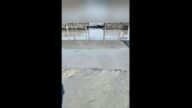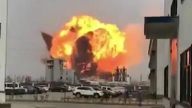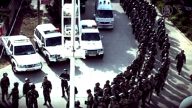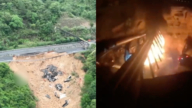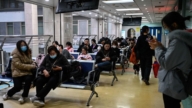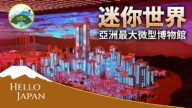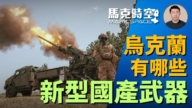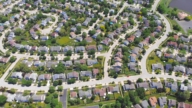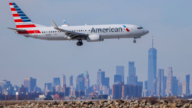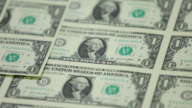【新唐人2013年12月17日讯】上海阴霾爆发,让国内精英越发加强移民海外的念头。中共当局治理阴霾无能为力,竟作出一项“掩耳盗铃”之举,那就是:上调阴霾警报的指数水平,以减少警报次数。
上海的精英人士因为阴霾严重而加强了移民海外的想法。
他们接受美国《华尔街日报》采访者时,有的人表示﹕后悔回到中国,有的正在认真考虑移居海外,有的生意人正在考虑,在香港或新加坡设一个办公室,还准备把孩子早点从学校领出来,去海外渡假。
上海的精英人士说:“阴霾的影响很大,因为不能自由呼吸的感觉真的很糟糕。”
随着窒息上海的阴霾达到有害的水平,12月初,城市的环境当局采取一个行动来应对频繁的空气质量警报。美国《彭博社》10号报导,上海环境保护局决定降低发布污染警报的标准,也就是,只在PM2.5的空气悬浮微粒达到每立方米115微克浓度的时候,才会发布警报。而先前的警报标准是每立方米75微克。
上海港务局退休职工殷伟伟:“这个弄虚作假,自欺欺人,他想要求降低以后,他可以报出来的级别看上去不是很严重。原来他制定超过多少指标要停课,工厂要停产。他如果标准降低以后,这个限制不是就宽了吗?学校不用停课,工厂不用停产。他在自己骗自己,骗老百姓。”
上海居民许正清:“这种做法是掩盖真相的做法,他根本就不是实事求是。而应该把事实真相告诉大家。应该采取更加预防的措施。从根本上解决一些问题。包括环境造成的污染问题。”
美国航天局的Terra卫星,在12月7号抓拍到一张图像,显示中国东部被阴霾包裹。厚重的阴霾从北京延伸到上海,大约1200公里的距离。
在这个图像被抓拍的当天,美国驻北京大使馆和美国驻上海领事馆的污染监控仪,各自记录到PM2.5的读数为每立方米480和355微克。根据世界卫生组织制定的标准,空气中PM2.5的浓度水平,应该低于每立方米25微克才被视为安全。
殷伟伟:“前两天很厉害。看上去灰濛蒙的,黄的。太阳是黄颜色的,光很弱的。看远处的建筑都只是一个影子,看不清楚。”
许正清:“很黑暗。白天感觉倒过来了,好像黑夜的状况。完全是看不清楚。人和人之间两、三米之内都看不见。一下子好像没有方向。特别是行车的,汽车开的很慢,生怕发生事故。”
“北京大学”研究指出,北京、上海、广东和西安等大城市,2012年因为空气污染而提早离世的人数,多达8,500人,经济损失超过60亿元人民币。
有报导说,污染和PM2.5正每天一点点的削弱人体健康,中国民众的身体每况愈下。大城市居民呼吸系统异常率明显上升,四成三市民曾出现疲劳、晕眩、心悸、呼吸困难等心血管系统异常症状。而人体吸入阴霾一段时间之后,肺脏都变成了黑色。
上海居民许正清表示,看到这些报导很担忧。他平时尽量减少外出,出门戴口罩。
许正清:“会产生一些呼吸道上面的问题。比如感到呼吸困难,呼吸道鼻腔感觉很难受,你觉得你的咽喉有咽痛,心脏里面感觉很压抑。”
殷伟伟:“我有个表哥,他原来就有肺部纤维化的毛病。他前两天就住了十几天医院。他虽然退休70多岁,我想肯定跟空气质量也有关系。”
亚洲开发银行与学术机构合作展开的一项研究显示,阴霾带给中国社会的经济损失,单是交通瘫痪,以及疾病增加两项,最高可能达到每年20万亿人民币以上。
采访编辑/秦雪 后制/钟元
Shanghai Smog Drives Immigration
The increasingly severe smog in Shanghai
is making many people want to emigrate.
The Communist regime’s measure to “cure" the pollution is
to lower air quality standards to make alerts less frequent.
Shanghai’s elite are thinking about immigrating
overseas because of the ever increasing smog problem.
In an interview with Wall Street Journal,
some of them said they regret returning to China.
Some are considering having an office set up in Hong Kong
or Singapore, and planning an early vacation with the kids.
A Shanghai businessman told WSJ, “The smog had a big
impact, because it feels really bad if you can’t breathe freely."
As the smog in Shanghai last week reached hazardous levels,
the city’s environmental authority took decisive action
to address the frequent air-quality alerts.
According to a Bloomberg report on Dec. 10,
Shanghai’s Environmental Protection Bureau decided to
lower the benchmark for alerting the public about
pollution risks.
It will now issue alerts only when the concentration of the
most dangerous particulates in the city’s air, known as PM2.5
(particulates smaller than 2.5 micrometers in diameter)
reach 115 micrograms per cubic meter.
The previous standard was 75 micrograms per cubic meter.
Yin Weiwei, Shanghai port authority retiree:
“It is self-deception and deceiving others.
With a lower standard, it will seem to be not as serious.
At a certain level, schools and factories were required to close.
A lower standard means schools and factories will stay open.
They are lying to themselves and the people."
Xu Zhengqing, Shanghai resident: “It’s to cover up the reality.
They don’t care about the facts.
What’s needed are the facts and deciding how to handle them.
They should try solving issues from the root,
including environmental pollution."
According to NASA, China suffered another severe bout of
air pollution as shown in an image
from NASA’s Terra satellite on December 7.
Thick haze stretched from Beijing to Shanghai,
a distance of about 1,200 kilometers.
NASA reported, “On the day this natural-color image
was acquired by Terra, ground-based sensors
at U.S. embassies in Beijing and Shanghai reported PM2.5
measurements as high as 480 and 355 micrograms
per cubic meter of air, respectively.
The World Health Organization considers PM2.5 levels
to be safe when they are below 25.
Yin Weiwei: “It was very severe two days ago.
It looked very much gray and yellow.
The sun is yellow but light beams are weak.
All you could see of buildings at a distance were shadows."
Xu Zhengqing: “Very dark. Day felt like night.
You can’t see anything clearly at all.
You won’t see the person as close as two to three meters away.
There is no sense of direction.
The motorists have to drive very slowly to avoid accidents."
According to a 2012 study by Peking University, air pollution
led to the untimely deaths of up to 8,500 people and economic
losses of over 6 billion yuan ($988 million) in major cities
such as Beijing, Shanghai, Guangdong and Xi’an.
It is reported that the pollution and particles of PM2.5 are
weakening China’s civilians’ health little by little every day.
Abnormal respiratory problems are increasing among
urban residents, 43% of them have experienced
cardiovascular abnormalities such as fatigue, dizziness,
palpitations, and difficulty breathing.
Prolonged inhaling of the haze makes lungs turn black.
Shanghai resident Xu Zhengqing says he worries about
the smog reports.
He tries not to go out and always wears a mask.
Xu Zhengqing: “It leaves you with respiratory problems,
such as difficulty breathing, great discomfort in the nasal
passages, you’ll feel you have a sore throat,
and the heart feels very depressed."
Yin Weiwei: “My cousin has pulmonary fibrosis.
He was hospitalized two days ago.
Though he is 70-years-old and retired,
I think it definitely also has to do with the air quality."
A study by the Asian Development Bank shows that,
considering the traffic gridlock and increased illnesses alone,
the annual economic loss the smog brings to Chinese society
could reach over 20 trillion yuan ($3.29 trillion).
Interview & Edit/QinXue Post-Production/ZhongYuan




